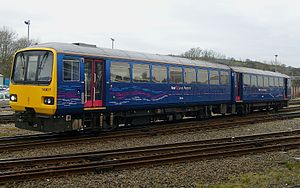British Rail Class 143
| British Rail Class 143 Pacer | |
|---|---|

A Great Western Railway Class 143 Pacer No. 143617 at Exeter TMD, opposite Exeter St. Davids Station. This was the first one to be refurbished for Great Western Railway.
|
|

The interior of a First Great Western refurbished Class 143
|
|
| In service | 1985 - present |
| Manufacturer | Hunslet-Barclay and Walter Alexander |
| Order no. |
|
| Family name | Pacer |
| Replaced | First generation DMUs |
| Constructed | 1985-1986 |
| Entered service | 1985 |
| Refurbishment | 1990s/2001-2002 |
| Number built | 25 trainsets |
| Number in service | 23 trainsets |
| Number scrapped | 2 trainsets (both due to fire) |
| Formation |
|
| Diagram |
|
| Fleet numbers |
|
| Capacity |
|
| Operator(s) | |
| Depot(s) | |
| Line(s) served | |
| Specifications | |
| Car body construction | Steel underframe. Aluminium alloy body and roof. |
| Car length | 15.546 m (51 ft 0 in) |
| Width | 2.695 m (8 ft 10.1 in) |
| Height | 3.515 m (11 ft 6.4 in) |
| Doors | Twin leaf pivot |
| Articulated sections | 2 |
| Wheelbase | 9.000 m (29 ft 6.3 in) |
| Maximum speed | 75 mph (121 km/h) |
| Weight |
|
| Prime mover(s) | |
| Engine type | 10-litre diesel |
| Cylinder count | 6 |
| Power output | |
| Transmission |
|
| Train heating | Engine waste heat, ducted warm air |
| Bogies | None, Ax1 fixed axle |
| Braking system(s) | Air |
| Safety system(s) | |
| Coupling system | BSI |
| Multiple working | Classes 14x, 15x and 170 |
| Headlight type | Fluorescent |
| Track gauge | 1,435 mm (4 ft 8 1⁄2 in) standard gauge |
The British Rail Class 143 is a diesel multiple unit, part of the Pacer family of trains introduced between 1985 and 1986. They originally worked in the North-East of England but were later transferred to Wales and South-West England.
The Rail Vehicle Accessibility (Interoperable Rail System) Regulations 2008 require that all public passenger trains must be accessible by 1 January 2020. No Pacer trains currently meet this requirement. Porterbrook has proposed an extensive refurbishment of the Class 143 and 144 units in an attempt to meet this requirement although this would significantly reduce the number of seats.Arriva Rail North must not operate any Pacer trains after 31 December 2019. They are required to order at least 120 new self-powered vehicles and are permitted to take on Sprinter and Turbostar units released by other franchises. The Long Term Passenger Rolling Stock Strategy for the Rail Industry indicates up to 500 non-electric carriages will need to be built in the short term.
The units are currently used on short distance services around Cardiff and Exeter. Previously they were common on services in the Bristol area.
At around the same time as the British Rail Class 142 was in development, a Pacer railbus was being developed by Kilmarnock-based Hunslet-Barclay. The units used a Walter Alexander bus body and entered service in 1985. Again with 2 × 205 bhp (153 kW) engines giving a total output of 410 bhp (306 kW) and a top speed of 75 mph (121 km/h), the class 143s originally had a capacity of 122 passengers per 2-coach unit.
As with all Pacer units, the 2-axle non-articulated wheel arrangement has given rise to problems with wheel noise on low-radius curves and poor ride quality in general. The interiors were completely changed in 2000, with bespoke Chapman high-back seating installed throughout, along with improved fittings, replacing 2+3 bus-style low-back seating; this reduced seating capacity to 106 seats per set.
...
Wikipedia
